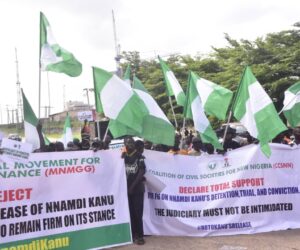When you read about mega data centres and artificial intelligence (AI) infrastructures being built across Africa, it is easy to be swept away by the promise, ‘Africa stepping into the digital frontier, building local infrastructure, and powering the future. But the harder truth is less desirable. For nations like Nigeria, joining the AI race comes at a steep cost, with big risks if the foundations are not sound.
In Nigeria’s case, the boom is real. In Lagos, for example, Airtel Nigeria is investing $120 million into a 38-megawatt hyperscale data centre at Eko Atlantic, explicitly created to support high-performance computing and AI workloads.
Rack Centre is building a 12 MW ‘AI-ready’ facility designed for high-density workloads and energy-efficient cooling in Lagos.
Across the data centre sector, Nigeria’s market was valued at about $278 million in 2024 and is projected to grow to $671 million by 2030, and power capacity for data centres is expected to grow sixfold to nearly 280 MW.
The picture is clear: Nigeria wants to bite into the AI opportunity. It has youth, it has demand, and it has ambition. But what exactly does it cost to keep up? And what are the trade-offs?
A data centre designed for AI is not like a typical server farm. It demands very high power loads per rack (think tens of kilowatts per rack), advanced cooling (liquid-immersion or direct-to-chip), and extremely low latency connectivity. In Nigeria’s hot and humid climate, and with an unreliable grid, that means extra layers of cost and complexity.
Take the power side. Nigeria’s grid remains unstable, outages are common, and many data centres must invest in hybrid energy systems: grid plus gas turbines plus solar or diesel backup. According to Schneider Electric, AI workloads consume significantly more energy than standard computing, and in Nigeria, that means innovation is only possible if data centres get serious about efficient cooling and power management.
Cooling is a big one. The tropical temperature means that traditional air cooling is less efficient, so data centres optimised for AI are adopting advanced systems. Rack Centre, for instance, builds with high-efficiency CRAHs, direct cooling and integrated building-management systems to handle high density.
Issue of connectivity. Nigeria has benefitted from subsea fibre cables (like Equiano and 2Africa) and improved terrestrial fibre networks, which are making local processing more feasible.
But building a true AI-ready data centre means combining connectivity with local compute, storage, skilled staff and low-latency access, all of which requires huge cost.
When, for example, a data-centre operator says, ‘We know AI is 95 per cent hardware,’ you understand how heavy the burden is. Beyond the upfront investment in infrastructure lies a deeper cost structure and strategic risk.
Energy cost and carbon footprint. The more compute you push, the more power you drain, and if the grid is not keeping up, it is either expensive backup, brownouts, or environmental trade-offs (diesel generators, high emissions). Nigeria’s data centre sector is acutely aware of this.
Talent and skills gap. Even with infrastructure, you need engineers, operators, cooling specialists, and AI model trainers. In many African nations, the talent is growing, but the gap remains. A data centre without the right people is a money burner. According to the State of AI in Africa report, training pipelines are still weak.
Operational risk and grid dependency. If you build a high-density GPU farm and you suffer frequent outages or your cooling fails, the compute goes idle, but costs keep accruing. In Nigeria’s environment, that risk is higher.
Strategic dependence or sovereignty risk. If a country does not build its computing infrastructure locally and relies entirely on external cloud providers or servers abroad, the latency, cost, and regulatory risks escalate. The data-centre boom is partly about AI sovereignty, i.e., being able to host locally, process locally, and govern locally. Nigeria’s investments reflect that.
But sovereignty has its cost. The bill for building cutting-edge facilities is steep, and smaller firms or governments may struggle to pay the full freight.
Why is Nigeria betting so heavily? Because the upside is enormous. With a median age of about 18, a population of over 200 million, and the largest tech ecosystem in Africa, Nigeria has the potential to become a regional AI hub.
But the expectation is high. If infrastructure lags or becomes unreliable, Nigeria risks falling behind. If talent drains to other markets, the investment will not yield returns. If energy costs become crippling, the computing advantage is lost.
The story of Nigeria’s data-centre boom is therefore dual – promise and peril. One major telecom-infrastructure player invests tens of millions to build the backbone of AI infrastructure; a major infrastructure engineering firm warns that unless power, cooling and connectivity keep up, the infrastructure may become a cost centre rather than a value creator.
In other words, building for AI is not optional if you intend to compete. But doing so poorly could be worse than doing nothing.
To make the cost worthwhile, Nigeria is to ensure reliable and sustainable energy. Without stable power, the high-density AI compute will not run. Nigeria must support hybrid systems, renewable integration and efficient cooling.
Also, the nation must build local talent and operations capacity. Infrastructure is useless without skilled operators and AI engineers. Training programmes, partnerships, and retention strategies matter.
We must prioritise infrastructure in places ready for it. For example, locations with better grids, fibre connectivity, security and disaster resilience (in Nigeria’s case, Lagos and environs become logical zones).
We must align policy and regulation. Data residency, digital economy strategy, and national AI plans all must support the infrastructure. Nigeria’s National Digital Economy Policy and Strategy 2020 – 2030 aims in this direction.
Above all, we must manage expectations and ensure usage. Building a centre is one thing; filling it with real workflows, local AI startups, and public-sector applications is another. Without demand, the cost becomes wasted capacity.
What does it cost to keep up with the AI boom in Nigeria? A lot. It costs money, power, talent, careful policy, and risk management. But to not keep up may cost even more, as Nigeria risks becoming a footnote in the global digital economy, outsourcing its computing, exporting its data, and missing the chance to build homegrown AI innovation.
As the continent moves deeper into the fourth industrial era, Nigeria’s investment in AI infrastructure could be the fulcrum between leadership and lagging. The build-out is already underway. The question now is, will the infrastructure perform? Will the talent and energy systems support it? Will the policy environment catalyse impact?
If the answers are yes, Nigeria may well capture a major slice of the AI wave. If the answers are no, the cost may turn into a burden, and the promise of Africa’s digital future may recede.









